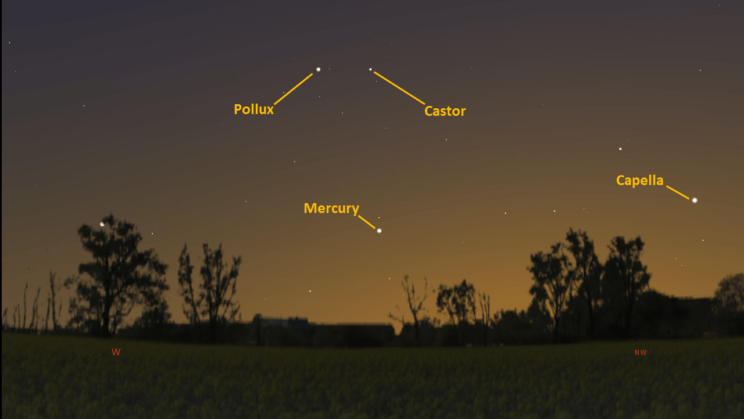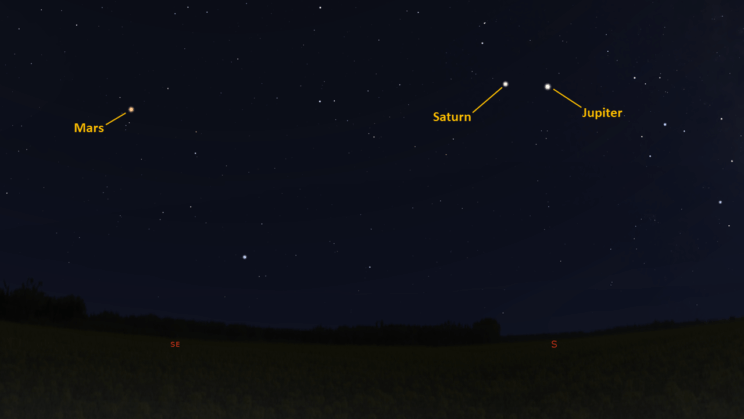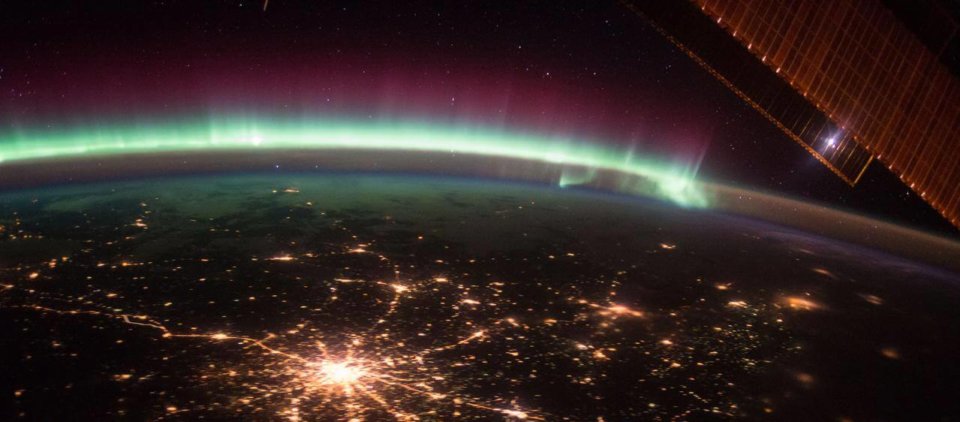This is the Saint Louis Science Center’s NIGHT SKY UPDATE for the week of Friday, June 5, 2020.
Information updated weekly or as needed.
Times given as local St. Louis time (CDT). For definitions of terminology used in the night sky update, click the highlighted text.
For now, star parties at the Saint Louis Science Center have been canceled due to recommendations from the CDC regarding COVID-19. All public telescope events are canceled until further notice. As conditions change, we will reevaluate and update this article once public observing events resume.
The Sun and Moon

The Moon as seen from the International Space Station, on July 31, 2011.
Credit: NASA
Sunrise is at 5:37 a.m. on Friday, June 5 and sunset is at 8:23 p.m. providing us with close to15 hours of daylight. Even after sunset, the light from the Sun will dimly illuminate our sky for roughly 2 hours. This period is called twilight, which ends around 10:12 p.m. this week. For those with a sundial, solar transit or local noon occurs around 1:00 p.m. this week.
| Day | Sunrise | Sunset |
|---|---|---|
| 2020-06-05 | 5:37 a.m. | 8:23 p.m. |
| 2020-06-06 | 5:37 a.m. | 8:23 p.m. |
| 2020-06-07 | 5:37 a.m. | 8:24 p.m. |
| 2020-06-08 | 5:36 a.m. | 8:24 p.m. |
| 2020-06-09 | 5:36 a.m. | 8:25 p.m. |
| 2020-06-10 | 5:36 a.m. | 8:25 p.m. |
| 2020-06-11 | 5:36 a.m. | 8:26 p.m. |
| 2020-06-12 | 5:36 a.m. | 8:26 p.m. |
| 2020-06-13 | 5:36 a.m. | 8:27 p.m. |
Moonrise for Friday, June 5 occurs at 8:32 p.m. and moonset will occur at 5:30 a.m. on the following day. On Friday, June 5 the Moon will exhibit a full moon phase. Full moon occurs at 2:12 p.m. before it rises in St. Louis. Full moon for June is often called the Full Strawberry Moon.
International Space Station (ISS) Observing

Visible passes of ISS from St. Louis for the week of June 5 occur during evening hours. The only pass of that occurs for the next week is on the evening of June 5. Use the table below for information about this pass of ISS.
A new group of Starlink Satellites was launched on June 3. Soon after a Starlink launch there are opportunities to see trains of satellites pass overhead. For those that have not yet seen one of these satellite trains they are impressive to see. The best opportunities this week to see the new Starlink group appear to be early morning passes. Visit www.heavens-above.com for more information.
Also, of interest is the conversation regarding the impact Starlink satellites will have on astronomical research. The American Astronomical Society has released a statement that covers their concerns regarding these impacts. It also mentions that they are in conversation with SpaceX to explore ways to mitigate these impacts. This statement can be found here www.aas.org
The launch of the Starlink 7 group of satellites is testing a visor system that was designed because of the conversations between SpaceX and scientists. SpaceX has stated in a conversation with astronomers that the first of the satellites with a visor is part of the Starlink 7 group and by flight 9 all Starlink satellites will be equipped with the visor. You can read more about it at www.spacex.com
Catch ISS from St. Louis starting Friday, June 5
| Date | Starts | Max. altitude | Ends | |||||||
|---|---|---|---|---|---|---|---|---|---|---|
| Time | Alt. | Az. | Time | Alt. | Az. | Time | Alt. | Az. | ||
| 05 June | -2.7 | 20:51:04 | 10 | WNW | 20:54:13 | 37 | SW | 20:57:21 | 10 | SSE |
Magnitude (Mag): The Measure of brightness for a celestial object. The lower the value is, the brighter the object will be.
Altitude (Alt): The angle of a celestial object measured upwards from the observer’s horizon.
Azimuth (Az): The direction of a celestial object, measured clockwise from an observer’s location with north being 0°, east being 90°, south being 180° and west being 270°.
For information about ISS flyovers and other visible satellites, visit www.heavens-above.com
Detailed information regarding all unmanned exploration of our universe, missions past, present, and planned, can be found at Jet Propulsion Laboratories:
The Visible Planets

Looking West, 40 Minutes After Sunset, June 5, 2020
Credit: Stellarium, EG

Looking Southeast, 4:00 am, June 6, 2020
Credit: Stellarium, EG
This week, four naked eye planets are visible. Mercury will be visible in the west about 40 minutes after sunset. Mars, Jupiter and Saturn are visible in the south and southeast in the morning hours before sunrise.
For those tracking Jupiter and Saturn as they approach their great conjunction later this year, the two gas giants currently appear just over 4° apart in the sky. If you keep watching them as 2020 progresses, you will see some interesting behaviors that inspired early astronomers to track the skies.
Mercury
Mercury is halfway through the current evening apparition. Mercury reached greatest elongation on June 4 so Mercury will appear to head towards the Sun each day. Mercury reaches inferior conjunction on June 30. We will continue to have good views of Mercury up to June 15, after which we will start losing Mercury to twilight skies. You can look for Mercury about 40 minutes after sunset in the west.
Mars
The red planet rises around 1:40 a.m. and will be high enough to see in the southeast by 2:40 a.m. Opposition for Mars occurs on October 13, 2020. As we head towards this date Mars will appear brighter and its surface will eventually be visible through a telescope.
Jupiter
The king of the planets is rising around 11:06 p.m. and should be visible in the southeast around 12:00 a.m. Each week you will find Jupiter rising about 30 minutes earlier than it did in the previous week.
Saturn
Saturn is rising around 11:22 p.m. Like Jupiter you will need a clear sky to the southeast to catch the ring planet around 12:30 a.m. Later this year Jupiter and Saturn will reach conjunction on December 21, 2020. You can track these planets as they appear to chase one another throughout the rest of this year.
2020 Great Conjunction
This year, the planets Jupiter and Saturn will reach conjunction. A conjunction is when two or more celestial bodies share the same right ascension. For Jupiter and Saturn, this astronomical event only occurs every 20 years. The conjunction will occur on December 21, 2020. You will find the two planets close together in the southwestern sky just after sunset on this date.
Visit the James S. McDonnell Planetarium for more information on what’s up!
Night Sky Update: June 5-June 13, 2020






